
The Society of Jesus, also known as the Jesuit Order or the Jesuits, is a religious order of clerics regular of pontifical right for men in the Catholic Church headquartered in Rome. It was founded in 1540 by Ignatius of Loyola and six companions, with the approval of Pope Paul III. The society is engaged in evangelization and apostolic ministry in 112 nations. Jesuits work in education, research, and cultural pursuits. Jesuits also conduct retreats, minister in hospitals and parishes, sponsor direct social and humanitarian ministries, and promote ecumenical dialogue.

Neo-Latin is the style of written Latin used in original literary, scholarly, and scientific works, first in Italy during the Italian Renaissance of the fourteenth and fifteenth centuries, and then across northern Europe after about 1500, as a key feature of the humanist movement. Through comparison with Latin of the Classical period, scholars from Petrarch onwards promoted a standard of Latin closer to that of the ancient Romans, especially in grammar, style, and spelling. The term Neo-Latin was however coined much later, probably in Germany in the late 1700s, as Neulatein, spreading to French and other languages in the nineteenth century.
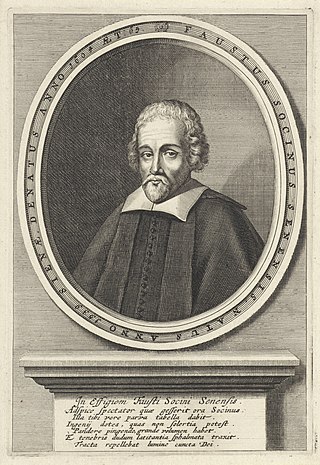
Socinianism is a Nontrinitarian Christian belief system developed and co-founded during the Protestant Reformation by the Italian Renaissance humanists and theologians Lelio Sozzini and Fausto Sozzini, uncle and nephew, respectively.

The Pontifical Gregorian University, is a higher education ecclesiastical school located in Rome, Italy.

The Latin school was the grammar school of 14th- to 19th-century Europe, though the latter term was much more common in England. Other terms used include Lateinschule in Germany, or later Gymnasium. Latin schools were also established in Colonial America.
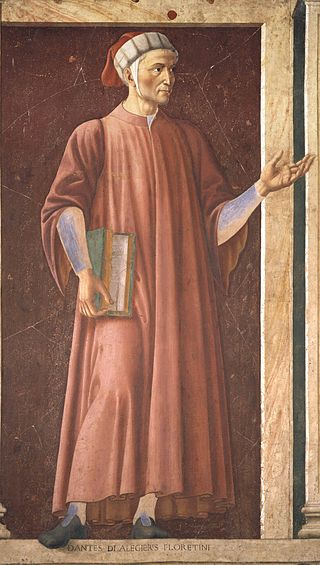
Renaissance Latin is a name given to the distinctive form of Literary Latin style developed during the European Renaissance of the fourteenth to fifteenth centuries, particularly by the Renaissance humanism movement. This style of Latin is regarded as the first phase of the standardised and grammatically "Classical" Neo-Latin which continued through the 16th–19th centuries, and was used as the language of choice for authors discussing subjects considered sufficiently important to merit an international audience.
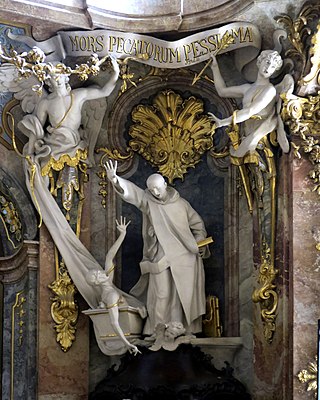
Cenodoxus is one of several miracle plays by Jacob Bidermann, an early 17th-century German Jesuit and prolific playwright. Jacob Bidermann's treatment of the Legend of the Doctor of Paris is generally regarded as one of the inspirations for Goethe's Faust.

Jesus is a masculine given name derived from Iēsous the Ancient Greek form of the Hebrew name Yeshua (ישוע). As its roots lie in the name Isho in Aramaic and Yeshua in Hebrew, it is etymologically related to another biblical name, Joshua.

Inspiration is an unconscious burst of creativity in a literary, musical, or visual art and other artistic endeavours. The concept has origins in both Hellenism and Hebraism. The Greeks believed that inspiration or "enthusiasm" came from the muses, as well as the gods Apollo and Dionysus. Similarly, in the Ancient Norse religions, inspiration derives from the gods, such as Odin. Inspiration is also a divine matter in Hebrew poetics. In the Book of Amos the prophet speaks of being overwhelmed by God's voice and compelled to speak. In Christianity, inspiration is a gift of the Holy Spirit.
Lutheran orthodoxy was an era in the history of Lutheranism, which began in 1580 from the writing of the Book of Concord and ended at the Age of Enlightenment. Lutheran orthodoxy was paralleled by similar eras in Calvinism and tridentine Roman Catholicism after the Counter-Reformation.

The Roman College was a school established by St. Ignatius of Loyola in 1551, just 11 years after he founded the Society of Jesus (Jesuits). It quickly grew to include classes from elementary school through university level and moved to several successive locations to accommodate its burgeoning student population. With the patronage of Pope Gregory XIII, the final seat of the Roman College was built in 1584 near the center of Rome's most historic Pigna district, on what today is called Piazza del Collegio Romano, adding the church of St. Ignatius in 1626, and a renowned observatory in 1787. The college remained at this location for 286 years until the revolutionary Capture of Rome in 1870.
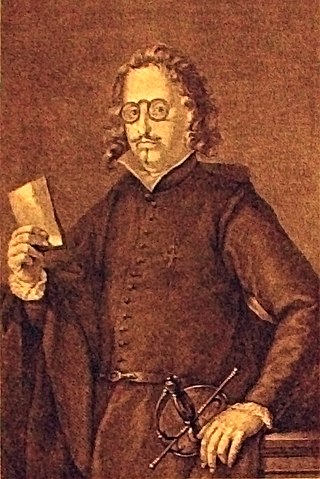
Conceptismo is a literary movement of the Baroque period in the Spanish literature. It began in the late 16th century and lasted through the 17th century, also the period of the Spanish Golden Age.
Academic drama refers to a theatrical movement that emerged in the mid 16th century during the Renaissance. Dedicated to the study of classical dramas for the purpose of higher education, universities in England began to produce the plays of Sophocles, Euripides, and Seneca the Younger in the Greek and Roman languages, as well as neoclassical dramas. These classical and neoclassical productions were performed by young scholars at universities in Cambridge and Oxford. Other European countries, such as Spain and Italy adapted classical plays into a mixture of Latin and vernacular dramas. These Spanish and Italian adaptations were used in teaching morals in schools and colleges. The intellectual development of dramas in schools, universities, and Inns of Court in Europe allowed the emergence of the great playwrights of the late 16th century.

Second scholasticism, also called Modern scholasticism, it is the period of revival of scholastic system of philosophy and theology, in the 16th and 17th centuries. The scientific culture of second scholasticism surpassed its medieval source (Scholasticism) in the number of its proponents, the breadth of its scope, the analytical complexity, sense of historical and literary criticism, and the volume of editorial production, most of which remains hitherto little explored.
Jacob Masen was a German Jesuit priest, historian, dramatist and theologian. He is known as a prolific writer in Latin.
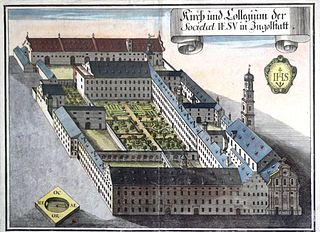
The Jesuit College of Ingolstadt was a Jesuit school in Ingolstadt, in the Duchy and Electorate of Bavaria, founded in 1556, that operated until the suppression of the Jesuit Order in 1773. The college was the headquarters of the Jesuits in Germany, and became a center of the Counter-Reformation. Many of its members taught at the University of Ingolstadt.

Spanish philosophy is the philosophical tradition of the people of territories that make up the modern day nation of Spain and of its citizens abroad. Although Spanish philosophical thought had a profound influence on philosophical traditions throughout Latin America, political turmoil within Spain throughout the 20th century diminished the influence of Spanish philosophy in international contexts. Within Spain during this period, fictional novels written with philosophical underpinnings were influential, leading to some of the first modernist European novels, such as the works of Miguel de Unamuno and Pío Baroja.

Eloquentia perfecta, a tradition of the Society of Jesus, is a value of Jesuit rhetoric that revolves around cultivating a person as a whole, as one learns to speak and write for the common good. Eloquentia perfecta is a Latin term which means "perfect eloquence". The term connotes values of eloquent expression and action for the common good. For Jesuits, the term eloquentia perfecta was understood as the joining of knowledge and wisdom with virtue and morality.
Neo-Latin studies is the study of Latin and its literature from the Italian Renaissance to the present day. Neo-Latin is important for understanding early modern European culture and society, including the development of literature, science, religion and vernacular languages.















